2020 in many ways was a horrible year but in political terms it marked a turning point for the independence movement, as support for independence grew and began to dominate the polls. Let’s take a look at the trend for the year and see what it tells us about the likely future direction for Yes support.
The year started with a 50/50 poll by Survation for Progress Scotland and the next three polls didn’t change that much; two found a slight Yes lead 51% and 52% and then the third rounded off the first quarter (Jan to March) when polling found No in the lead at 52%.
However, polls conducted with around 1,000 respondents are thought to have a + or – 3% statistical variance when extrapolated to represent the views of the whole nation – so all of those polls told us that Scotland was split in a fairly even statistical tie. That’s borne out by the average of the first quarter (Q1) polling coming out at 50.5% a small but largely meaningless lead for independence.
The Q1 average was brought down a little by the final poll of March, which gave No 51%. It may be that worries about lockdown may have initially favoured the union, people in a time of crisis tend to feel better the devil you know and incumbent governments around the world dealing with Covid-19 did regularly receive boosts in the polls. If that was the case it was not to continue for obvious reasons.
Q2 started at 50/50 again, this time Panelbase for the website Wings over Scotland. No real change from Sir Kier Starmer becoming UK Labour leader.
Helpfully the three polls in Q2 were all by Panelbase so are more directly comparable and they showed an interesting trend; in early June, Panelbase for the polling website, ScotGoesPop, found 52% now at the top end of the statistical variance, so good news but no breakthrough.
The SNP Government is also an incumbent and as the crisis progressed a clear gap in satisfaction between the Scottish Government’s crisei management versus Westminster’s started making people feel more confident in Scotland’s ability to manage its own affairs. Both governments were being tested and Scotland was performing well whilst Westminster was failing that test.
So 52% Yes surprised the team at BfS, we felt that the mess the Conservative government was making of its Covid-19 response must have been having a bigger impact and so we put our own poll in place, firmly believing we would get 53% or 54% – and we did in late June. Remember the + or -3% rule, well 54% was the first poll to give Yes a lead of more than 3%and that sent panic waves through the UK cabinet (according to The Times). Boris Johnson flew up to Scotland and so did Rishi Sunak, which left us speechless as we saw it as meaningless showboating completely likely to backfire – and it did.
54% was the first real polling news story of the year and the narrative on independence started to change as news outlets in the UK and across the world started to believe that Brexit would break the Union. Looking for a Yes/No poll story though is a bit of a lottery so we added many other questions and found other stories that the press lapped up, such as 70% of Scots have more confidence in the Scottish Government to manage the economy compared with Westminster and that 55% thought independence would be good for the Scottish economy. That represented a 10% lead in confidence in the independent economy of Scotland. We also found that 68% thought that Brexit would be bad for Scotland’s economy. This included 68% of Labour voters, a massive 89% of Lib Dems, 84% of SNP supporters and even 28% of Conservative voters.
The Q2 average ended up at 52% Yes (up 1.5% on Q1) but the Union’s defences were breached and the faith in the economy, Covid-19 management compassion and worsening Brexit negotiations all pointed to independence support gaining momentum.
A few sceptics wondered whether BfS had somehow convinced Panelbase to skew the figures (you can’t) but helpfully the first poll in Q3 Panelbase for the Sunday Times confirmed our 54%. In early August YouGov put Yes at 53%, then SavantaComRes found 54%.
We knew that 55% Yes – a complete reversal of the 2014 referendum result – was coming and we were determined that we would commission the poll that got the reversal so that we could spin it and not have some unionist newspaper downplay its significance. We postponed it three times and finally went from the 12th of August to the 18th of August and got 55%.
Our press release carried the headline that the 2014 independence referendum result had been reversed and almost every UK news outlet carried that headline, thus changing the narrative on independence from “wow, it looks like Yes is in the lead’ to “independence is inevitable”. This was key to many undecided voters who now saw that they would be joining the majority and the winning side, making it easier for them to opt for Yes and to take the Yes case more seriously. Survation (which always put Yes 1 or 2% below where we expect it to be) found 53% Yes in early September which didn’t surprise us, as our 55% was a round-up and we only got it by 0.1 of a percent (skill in the timing, yes but lucky as well), then JL Partner got 56% to round out Q3 at an average of 54% (up 2% from Q2, a trend was now obvious).
The political story of Q3 was the appointment of Douglas Ross as Conservative leader (with Ruth Davidson deputising for him in the Scottish Parliament) in early August but that clearly had no impact on the Yes vote, if anything potentially the manner in which a non-MSP of no real note was forced upon the Scottish branch could have backfired somewhat.
Independence was now the political story of the year and so everyone and their dogs started to poll in Q4. Not BfS; we decided to wait till 60% was in play, which we predicted would happen after Brexit. IpsosMori found a record 58% Yes in early October, independence now in the lead by 12%, but many thought it was a rogue poll. Q4 polling was confusing, ending with SavantaComres finding another 58% Yes. But with a 51%, a 52%, two at 53%, one at 54% and two at 56%, Q4 ended up at 55% (up 1% from Q3) but we felt that was downplaying the progress in Q4.
Individual polls can be volatile and the slight variances in methodologies between polling companies can mean that some often state Yes support as higher or lower than others and until you actually have a referendum you just cant tell who is right. So looking at the poll of polls the average of the last 3 or 5 etc can paint a better picture but looking at the quarterly averages best tells the story of 2020.
Not in our graph but the first poll of 2021 found 57% Yes. This suggests the Brexit deal has not helped the Union as people feel it’s not a good deal and that it was very last minute. That poll also predated the resignation of Richard Leonard as Labour’s Scottish branch leader and that can’t really have a positive impact on the polls for unionists. So if the next poll comes out at 55%, then the most recent three poll average will be 57% – and we think that would be about right.
Conclusions
We polled six times in 2020 but only asked the Yes/No question twice, never asking party voting intentions as our polls were mainly for policy research purposes. What we found though was that three key trends were driving the increase in Yes support in 2020.
Scotland’s economy is run by Westminster and the Conservative Government’s Brexit omnishambles with its comparatively poor performance in handling COVID-19 is driving more and more people to believe in Scotland’s ability to manage its own economy. This is BfS’s key message and we’ve found getting that across is becoming easier and easier.
The mismanagement of Brexit by the Westminster Government and the significantly better performance of the Scottish Government in handling the health crisis are the key factors driving support for Scottish independence. The UK was held together in 2014 by economic scaremongering and the promise that the UK would stay in the EU. Brexit has already disproved one of those unionist promises and has largely dismantled the economic case for the UK.
The political response from the Westminster parties has been to change the leaders – the message stays the same but the faces change -and so none of of those knee jerk reactions have helped the unionist cause at all – they may indeed be hampering it. The momentum will likely stay with the Yes movement in Q1 2021 and, scaremongering in particular, will not work this time as people have heard it all before; its efficacy depends on the credibility of those making the claims and the Westminster Government and its Labour supporters have precious little economic or managerial credibility left.

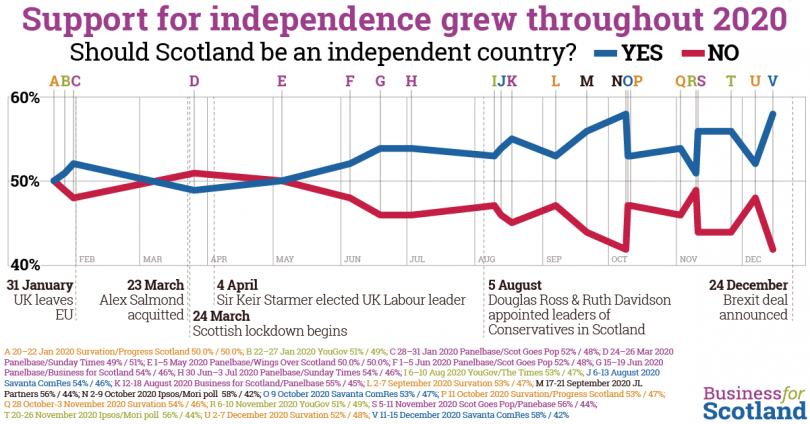
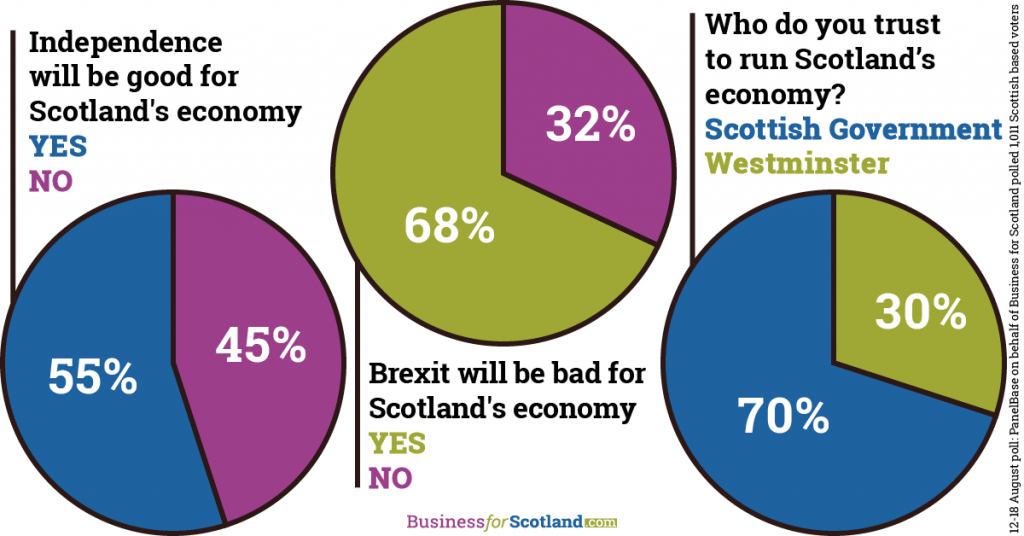
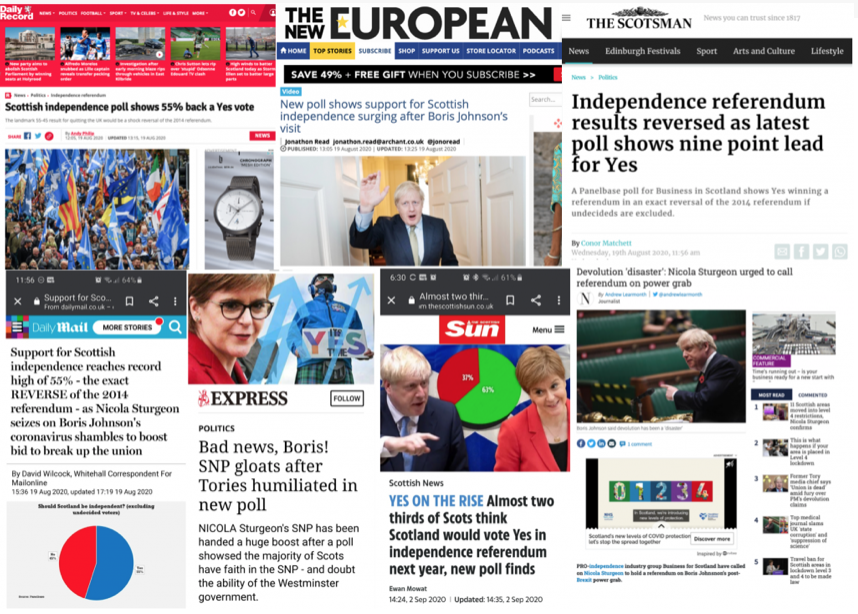
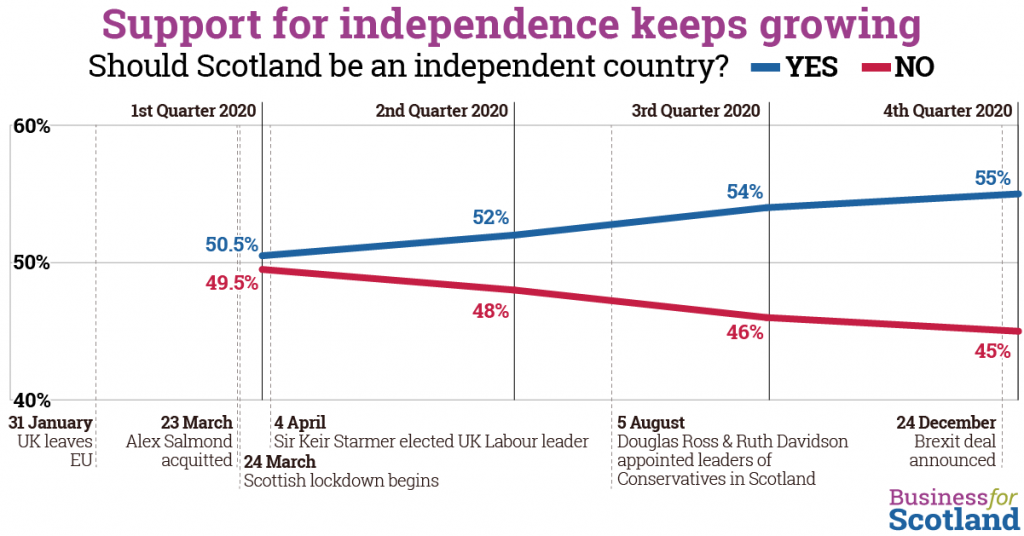
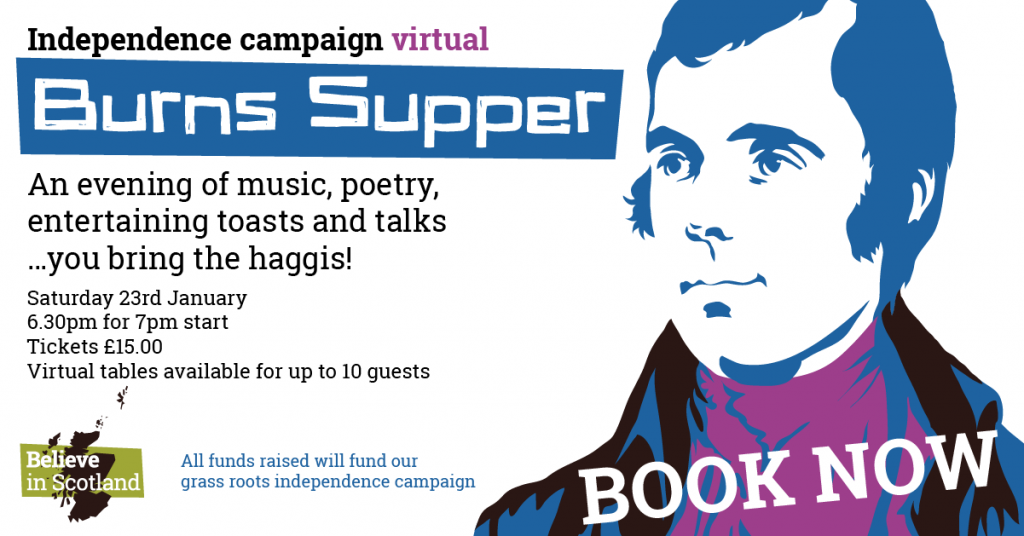






In my view three reasons 1 Nicola Sturgeon 2. Boris Johnson 3. Lord Snotty
Among my X -unionest mates that is what they say! Ms Sturgeon is the Captain of the ship and it shows. Boris is seen as nice but dim Jacob Rees-Mogg everything they dislike. It made no difference to my view.